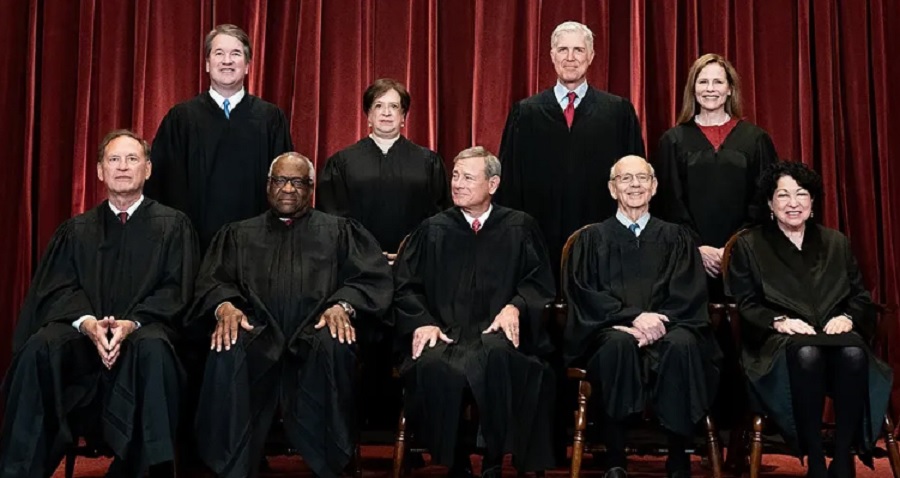
On the last day of the latest session of the U.S. Supreme Court, the justices ruled that President Joe Biden’s Environmental Protection Agency (EPA) can’t expand their authority to curb greenhouse gasses and that the ability to do so remains in the law-writing branch of the government at Congress.
The case before the U.S. Supreme Court was West Virginia vs. Environmental Protection Agency (EPA). The case was last heard by the Court in February. The primary plaintiff of the case is West Virginia Attorney General Patrick Morrisey; he is joined by attorney generals from Alabama, Alaska, Arkansas, Georgia, Indiana, Kansas, Louisiana, Missouri, Montana, Nebraska, Ohio, Oklahoma, South Carolina, South Dakota, Texas, Utah, and Wyoming. Morrissey’s office is also representing the interests of two coal companies in the case.
Ultimately, the plaintiffs argued that the EPA doesn’t have the authority to regulate power plant emissions and that Congress should be granted that authority. The plaintiffs argue that decisions around emissions should be at the hands of elected officials and not the EPA. The EPA responded to the argument by saying that the Court should not read into the text an artificial restriction because any qualification would be directed at the states, not the federal agency.
The EPA, backed by the administration of President Joe Biden, is being represented by the U.S. Solicitor General.
Today, the Court ruled in favor of West Virginia in a 6-3 vote.
“Capping carbon dioxide emissions at a level that will force a nationwide transition away from the use of coal to generate electricity may be a sensible ‘solution to the crisis of the day,’” Chief Justice John Roberts wrote, joined by the five other justices of the court.
“But it is not plausible that Congress gave EPA the authority to adopt on its own such a regulatory scheme in Section 111(d)” of the Clean Air Act, he concluded. “A decision of such magnitude and consequence rests with Congress itself, or an agency acting pursuant to a clear delegation from that representative body.”
The White House released a statement from President Joe Biden expressing disappointment in what has been one of a series of Supreme Court decisions that have outlawed many of President Biden’s policies. “The Supreme Court’s ruling in West Virginia vs. EPA is another devastating decision that aims to take our country backwards. While this decision risks damaging our nation’s ability to keep our air clean and combat climate change, I will not relent in using my lawful authorities to protect public health and tackle the climate crisis,” the statement read.
Since becoming law, the Clean Air Act has seen significant amendments added over time, with 1977 and 1990 increasing the authority and responsibility of the federal government.

After the Clean Air Act’s first 20 years, in 1990, according to the EPA, it prevented more than 200,000 premature deaths and almost 700,000 cases of chronic bronchitis were avoided. From 1990 to 2010, total emissions of the six principal air pollutants decreased by more than 41 percent, while the Gross Domestic Product increased by more than 64 percent.
In recent years, some have wanted to expand the scope of the Clean Air Act to tackle climate change. While the science remains inconclusive, many scientists believe there is a link between air pollution and an evolving global climate, with some expressing the theory that carbon dioxide, the primary byproduct of gas and diesel engines and fossil-fueled power plants, is impacting global temperatures around Earth.
In the 1970 law, the EPA was required to issue new “standards of performance” for every newly constructed “stationary sources” of pollution, which include power plants. All regulations of power plants must undergo this process and the federal government partners with state governments to ensure EPA standards are met through coordinated enforcement measures.
In 2015, President Barack Obama’s administration set the Clean Power Plan within the Clean Air Act. The Clean Power Plan (CPP) set the first-ever limits on carbon pollution from U.S. power plants. The intent of President Obama’s plan was to rein-in power plant pollution and speed transition away from fossil fuels, citing climate change as the primary reason for the the updated rule.
In 2019, President Donald Trump’s administration killed the Clean Power Plan. Then-EPA Administrator Andrew Wheeler criticized the Obama policy, saying, “The CPP would have asked low- and middle-income Americans to bear the costs of the previous administration’s climate plan.” Wheeler added, “One analysis predicted double-digit electricity price increases in 40 states under the CPP.”
In a 2007 Supreme Court case, the Justices ruled 5-4 in Massachusetts vs. EPA that the agency has to limit greenhouse gases under the Clean Air Act if they’re a threat to public health. In a 2009 endangerment finding, the EPA determined carbon dioxide was indeed a threat to public health. Based on that Supreme Court ruling, the Trump administration couldn’t simply kill the CPP; it needed to have a plausible replacement to it.
With the CPP repealed, the Affordable Clean Energy (ACE) rule was put in its place. The ACE rule establishes emission guidelines for states to use when developing plans to limit carbon dioxide at their coal-fired electric generating units.
The ACE rule was short lived, however. On January 19, 2021, the D.C. Circuit Court vacated the Affordable Clean Energy rule and remanded to the EPA for further proceedings consistent with its opinion.
At this time, President Biden and the EPA hasn’t revived President Obama’s Clean Power Plan, saying they want to formulate their own regulations for power plants. But with the Supreme Court ruling the way they did today, that could become extremely difficult without Congress’s help.